Three main deserts exist in the state of California: the Mojave Desert, the Great Basin Desert, and the Colorado Desert. Within these deserts lies diverse wildlife. Some creatures roaming California sands are highly dangerous. In fact, many deadly desert animals possess highly potent venom that can break down a human’s bodily functions. Discover the top seven most dangerous animals in California deserts and find out which ones can be fatal.
1. Bark Scorpion
The bark scorpion, also called the Arizona bark scorpion, is a highly venomous creature found in the deserts of the Southwest, including California. Bark scorpions are considered a threat to human life, as they are the most venomous scorpion species in the country. However, only four fatalities from bark scorpions have been reported from 2010 to 2021.
Bark scorpions reside in a variety of places within the deserts of California. Due to the high temperatures of the desert environment, bark scorpions prefer shaded areas to keep themselves cool. While they typically find shade beneath rocks or on trees, they may also escape into households, hiding in closets or bathtubs. Bark scorpions are not uncommon, considering their wide range. As predators, they feed on insects, other scorpion species, and spiders.
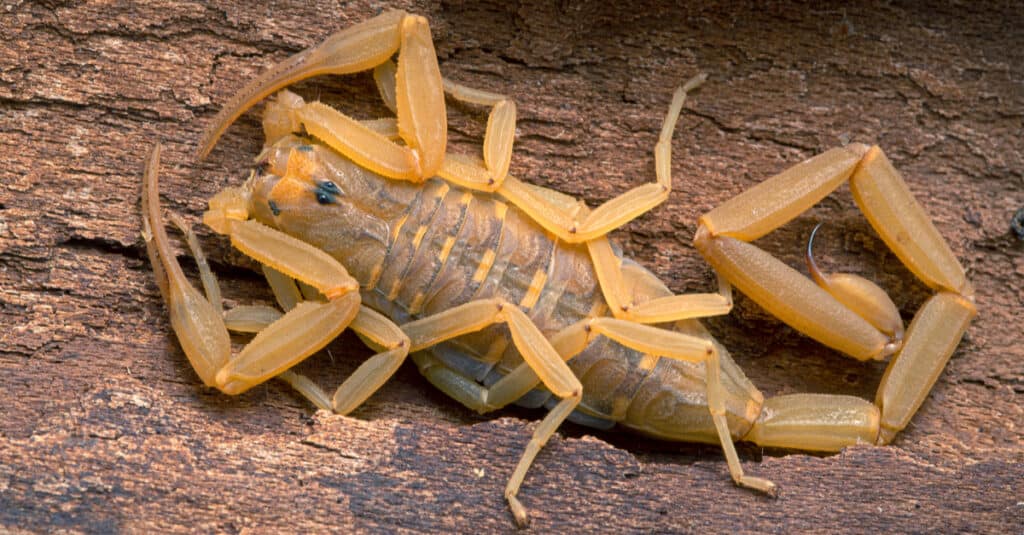
Arizona bark scorpions have caused four human deaths over 11 years, as of 2021.
©Ernie Cooper/Shutterstock.com
2. Mojave Green Rattlesnake
Mojave green rattlesnakes are a venomous snake species whose venom may be neurotoxic or hemotoxic. Neurotoxic venom attacks the body’s nervous system, while hemotoxic venom attacks the blood. Mojave green rattlesnakes live in several habitats, including deserts, grasslands, shrubland, and forests. Some desert areas that are home to the Mojave green rattlesnake include Los Angeles, Kern, and San Bernardino Counties.
Mojave green rattlesnakes feed on several kinds of prey, including lizards, small mammals, and snakes. As an ambush predator, the Mojave green rattlesnake will wait for prey and attack quickly and viciously. After biting, this snake releases venom and swallows the prey whole.
These snakes display a brown or pale green coloration with a diamond pattern along their back. They range between 2 and 4 feet in length but may achieve lengths up to 4.5 feet.

Mojave green rattlesnake venom may be hemotoxic or neurotoxic, making bites difficult to treat.
©iStock.com/Shoemcfly
3. Sidewinder Rattlesnake
Sidewinder rattlesnakes, or horn vipers, encompass four distinct species found in California deserts. They also reside in deserts throughout Africa, the Middle East, and North America. The term “sidewinder” derives from the snake’s peculiar way of slithering, which aids them in moving quickly across loose sand.
Sidewinder rattlesnakes in the United States are nocturnal, hunting during nighttime for prey like lizards and rodents. Most sidewinders measure just over 20 inches long, but they may attain a maximum length of 31.5 inches. These snakes are venomous, but they are also shy, meaning they rarely encounter or bite humans. Their coloration may appear gray, pink, orange, or tan, and typically reflects their environment, specifically the desert sands upon which they move.
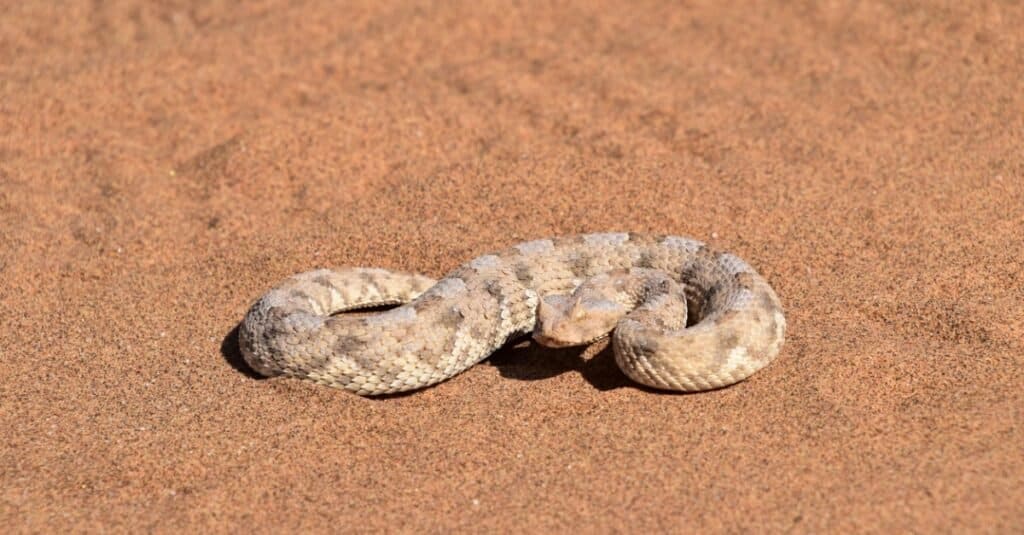
Sidewinder rattlesnakes utilize a unique slithering technique called “sidewinding” to move across sand.
©iStock.com/Josh Mitchell
4. Southern Pacific Rattlesnake
The Southern Pacific rattlesnake is considered one of California’s most venomous snake species. The venom of this snake is not only highly toxic but can be fatal, too. Southern Pacific rattlesnakes are nicknamed “people-biting rattlesnakes” because they account for most snakebites between the San Diego and Los Angeles coastal areas. In general, though, these rattlesnakes will only strike humans if they feel threatened or have been provoked. In fact, venomous snake bites in California are not as common as many people believe. Venomous rattlesnake bites only cause one to two fatalities annually in this state.
The range of the Southern Pacific rattlesnake extends from Baja California, Mexico up to Southern Santa Barbara. While this rattlesnake is found in desert scrub, it may also reside in fields, grasslands, forests, or mountains. This snake is nocturnal, hunting reptiles, birds, mice, and frogs during the night. Adult Southern Pacific rattlesnakes may wait up to two weeks between meals, while juveniles must eat once a week to mature.
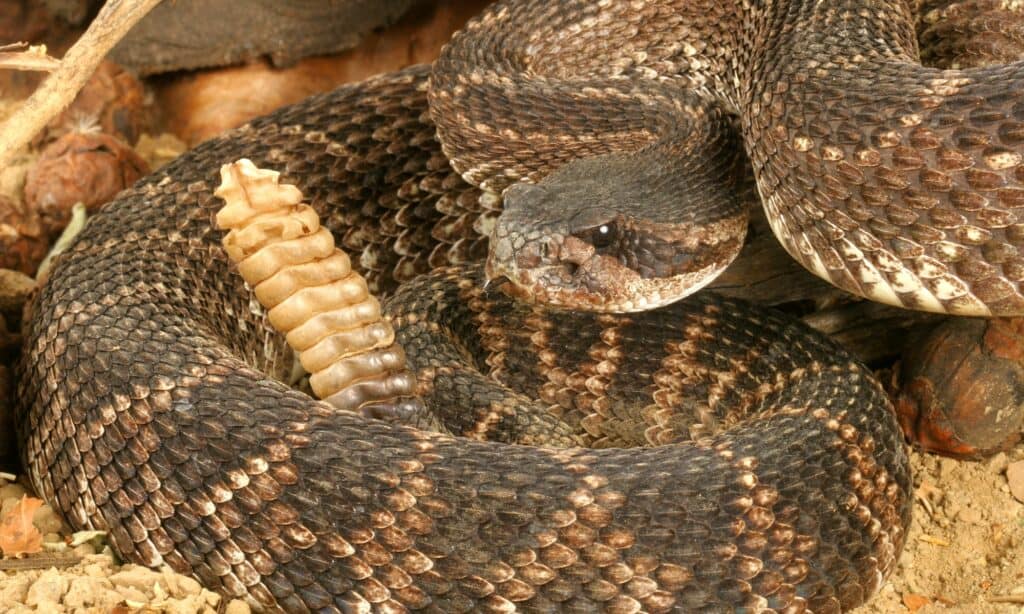
Southern Pacific rattlesnakes account for the most snakebites in the Los Angeles and San Diego areas.
©iStock.com/johnaudrey
5. Desert Recluse Spider
Desert recluse spiders may be found in a variety of desert habitats, including the Mojave and Sonoran deserts amongst others. Like the common brown recluse spider, which is often found in many households across the United States, the desert recluse possesses necrotic venom. This venom results in skin blisters around the bite area and other serious symptoms if left untreated. Many people mistake the desert recluse spider for a brown recluse. However, the desert recluse only possesses six eyes, while the brown recluse has eight.
Desert recluse spiders may range from a quarter to half an inch in body length. Their body coloration typically ranges from tan to dark brown, and, like the brown recluse, desert recluse spiders display a fiddle-shaped design on their bodies. Unlike the brown recluses, though, desert recluse spiders are rarely found indoors. The diet of this spider includes small insects, but they may feed on large insects that are already dead.
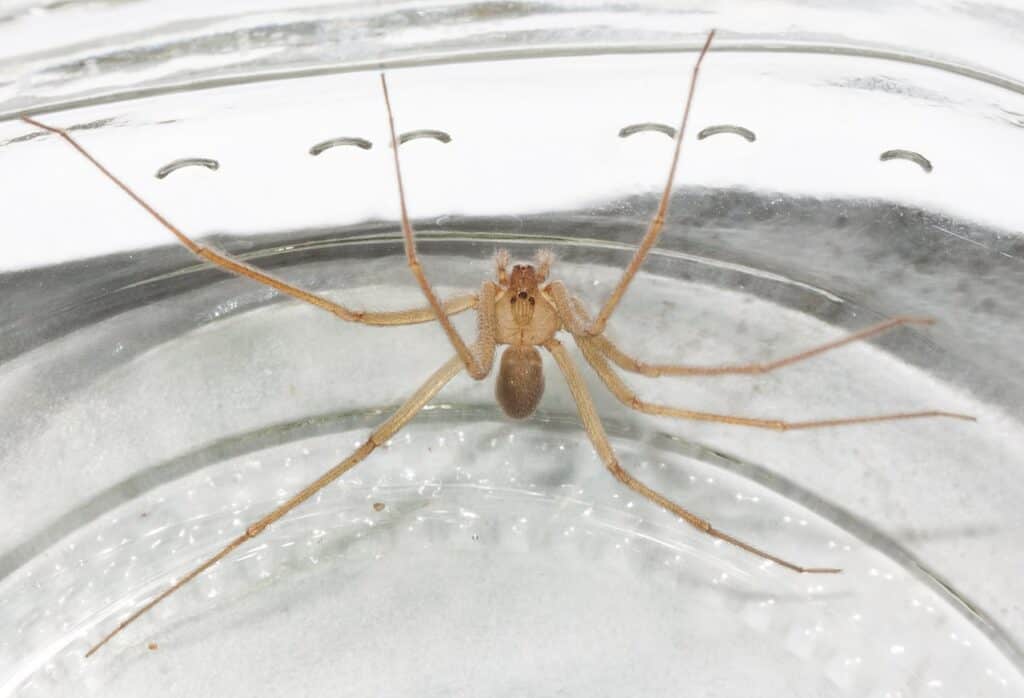
Desert recluse spiders possess necrotic venom, which results in skin blisters around the bite.
©DesertTrip / CC BY-SA 4.0, via Wikimedia Commons – License
6. Black Widow Spider
While most people across the United States encounter black widow spiders in their homes or forested areas, this spider also thrives in deserts, specifically in the state of California. Black widows possess a strong venom that can cause muscle cramping, pain, or shortness of breath with a single bite. However, symptoms of a black widow bite may vary depending on the person bitten. Although a bite from a black widow can be severe and fatal, death from black widow venom is rare. Those that are bitten should seek medical attention immediately.
Black widows are found in various places across the globe, including the United States. Habitats of the black widow include deserts, rainforests, mountainous regions, and grasslands. The spider’s body coloration appears black with a red hourglass-shaped marking on its abdomen. The diet of the black widow includes a variety of insects, other arachnids, and small organisms.
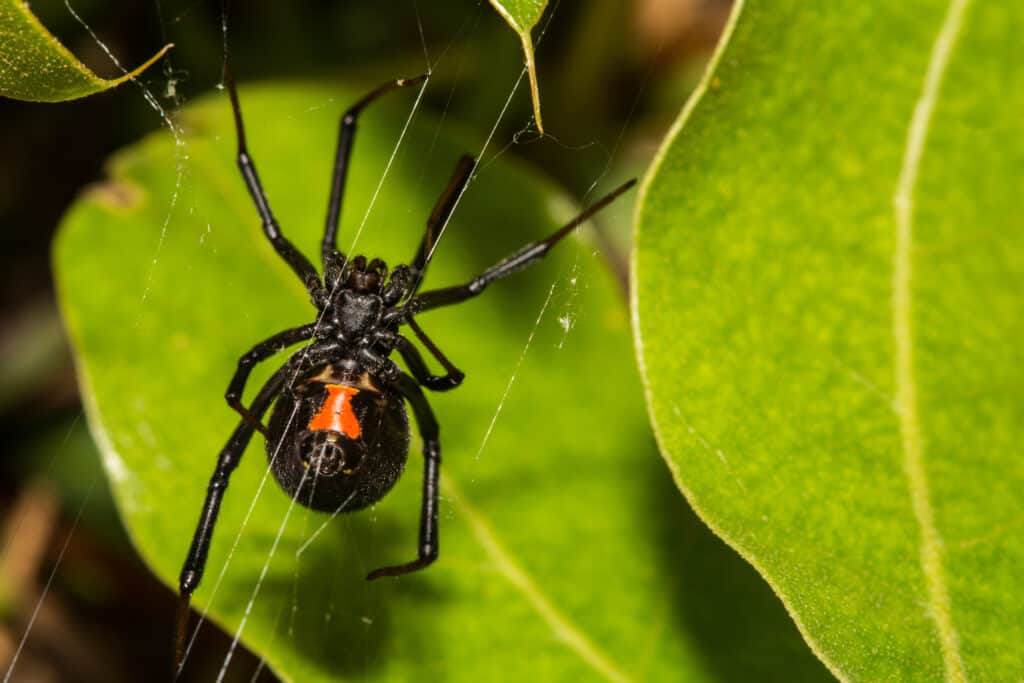
Black widows display a red hourglass shape on their body, which helps in identifying them.
©Jay Ondreicka/Shutterstock.com
7. Africanized Honeybees
Africanized bees may also be called killer bees due to their dangerous characteristics. While Africanized honeybees (AHB) appear similar to the common honey bee, they are far more lethal. In fact, AHB were introduced into Brazil in the 1950s when European honey bees began to mate with bees from Africa, resulting in AHB offspring. Eventually, AHB made their way to California in 1994. Today, AHB exist throughout Southern California, including in desert habitats, and they may advance into Northern California.
AHB are known for their high levels of aggression, and they are more defensive than their European counterparts. In fact, AHB may deem humans threatening without prior provocation; even standing close to an AHB colony can result in an attack. Many bees of this species attack all at once, stinging victims repeatedly. People that are allergic to bees are most at risk of death from an AHB attack, but children, elderly people, and those with disabilities are also vulnerable.

Africanized bees are also called killer bees because they cause many deaths across the country every year.
©Pamela Au/Shutterstock.com
The photo featured at the top of this post is © Ernie Cooper/Shutterstock.com
Thank you for reading! Have some feedback for us? Contact the AZ Animals editorial team.






